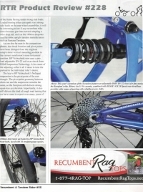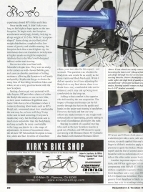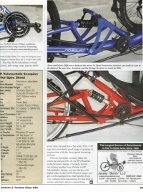Pressespiegel – Recumbent & Tandem Rider Magazine #55
HP Velotechnik im Spiegel der Medien: Der folgende Text ist ein Auszug aus der Zeitschrift Recumbent & Tandem Rider Magazine #55 (2016). Wir empfehlen für die komplette Lektüre einen Besuch der Web-Site.
HP Velotechnik Scorpion
Updated, upgraded, outstanding.
By Charles Coyne
HP Velotechnik’s big news for this fall is the introduction of their redesigned Scorpion recumbent trike. HP has produced the original Scorpion with 20″ wheels since its initial introduction back in 2005, and it has been one of their bread-and-butter machines ever since. Iterations, or evolutions, introduced over the years have included the Scorpion fx – a foldable touring trike with 20″ wheels; the Scorpion fs – a foldable touring trike with front suspension in addition to the rear No-Squat suspension, also fitted with 20″ wheels; the Scorpion fs 26 with full suspension and a 26″ rear wheel; the Eurobike Award-winning Scorpion fs 26 Enduro for off-road romping; the electric-assist S-Pedelec Scorpion fs 26, as well as the „higher, wider, more comfortable“ Scorpion Plus 20 and the Scorpion Plus 26.
 So, what’s different between the original Scorpion and the newest version? The most obvious change is its profile due to the switch from a 20″ rear wheel to the increasingly popular 26″ rear wheel combo. Whether it’s fade, fiction, or fate, the trend in trikes does seem to be leaning towards the larger rear wheel sizes, and HP Velotechnik now looks to be becoming even more invested in the concept.
So, what’s different between the original Scorpion and the newest version? The most obvious change is its profile due to the switch from a 20″ rear wheel to the increasingly popular 26″ rear wheel combo. Whether it’s fade, fiction, or fate, the trend in trikes does seem to be leaning towards the larger rear wheel sizes, and HP Velotechnik now looks to be becoming even more invested in the concept.
The stiff, strong backbone of the Scorpion’s frame remains the same, along with the swept-forward cross-member. Some reengineering of HP’s original NoSquat suspension system was required with the introduction of 26″ rear wheel. To better manage the additional side torsional forces caused by the taller wheel (taller wheel = longer lever), HP incorporated a newer rear triangle assembly.
This newer No-Squat system had previously been incorporated into other versions of the Scorpion over the years, including the Scorpion fx, fs 26, fs 26 Enduro, the fs 26 S-Pedelec. the Plus 20 and the Plus 26. The difference between the original No-Squat rear triangle and the newer version can be seen by comparing the photo of the orange-colored Scorpion from our test in 2006 with the similar photo taken of the new trike. The wider ‚wing flange‘ spreads the forces over a wider area, minimizing any chance of the frame flexing under strong side loads. Loaded touring trikes can apply very strong side loads on the rear wheel assemblies, it will be interesting to see if any recumbent trike manufacturers gravitate toward adapting a sider drop out, such as the 160mm dropouts used by some upright tandem manufacturers such as Santana Tandems.
 As can also be seen in the comparison photos, the shock location and pivot points have been changed from the originals setup’s more vertical mounting position to the current installation’s more horizontal position. HP Velotechnik now uses a pre-load adjustable DV-22 coil-over shock from DNM Suspension Technology. A few turns of the adjusting collar is all it takes to tune the preload to the individual rider’s desire.
As can also be seen in the comparison photos, the shock location and pivot points have been changed from the originals setup’s more vertical mounting position to the current installation’s more horizontal position. HP Velotechnik now uses a pre-load adjustable DV-22 coil-over shock from DNM Suspension Technology. A few turns of the adjusting collar is all it takes to tune the preload to the individual rider’s desire.
The key to HP Velotechnik’s NoSquat suspension is the pivot point of the rear triangle. The pivot point geometry between chain run and the suspension remains the same, so the Scorpion still delivers strong, squat-less acceleration. lmportantly, it also still delivers the kind of rough road taming that we have come to expect over many years of experience aboard HP’s bikes and trikes.
Once on the road, it didn’t take very long to feel right at hope again on the new Scorpion. To begin with, the Scorpion accelerated satisfyingly briskly, belying its all-up weight of 39.5 lbs. With its „scorpion-shaped“ frame doing an excellent job of weight distribution, coupled with a low center of gravity and nimble steering, the Scorpion feels like a much lighter rig. lts nimbleness does not translate to twitchyness at higher speeds as might be suspected. Attribute that to the bike’s weil-designed indirect under-seat steering.
Our review trike was fitted with Schwalbe’s Kojak tires. They were as sticky in the corners as well-chewed bubble gum, and cause an absolute minimum of rolling resistance, allowing the Scorpion to roll easily and quickly. Kojaks are the go-to choice for many fans of fast riding recumbent bikes and trikes, so are a very good inclusion with the new Scorpion.
Seating choices get very personal with trike buyers, HP provides a choice of either the BodyLink seat as on our review bike, or their more traditional ErgoMesh seat. Some folks have a bit of hesitance when it comes to thinking about seats such as HP’s BodyLink, concerned about how comfortable the seat may be, or how well they’ll stay in the seat in hard cornering. Everyone’s results may vary, but tbe BodyLink seat is much more adjustable than the ErgoMesh, and may actually be more comfortable in the long run, due to its wide range of adjustments. In terms of recumbent trikes, the all-new HP Velotechnik Scorpion is lean, low, sleek and fast. In terms of recumbent riders, your test rider for this report – not so much. The question was whether the BodyLink seat would be as comfy as the more traditional ErgoMesh unit. While 1 did not spend a lot of time adjusting the BodyLink to my final desire, there is no doubt that a very comfortable ride can be obtained, and it may end up being more comfortable in the long run.
 Adding to that comfort is the superior ride delivered by the rear suspension. The impact of bumps and thumps can be felt mostly through the feet on the pedals and hands on the under-seat steering’s handlebars. However, the back and butt are very effectively made immune to any rough-road-inflicted jolts or hammering, greatly adding to the level of confidence allowed by the rider.
Adding to that comfort is the superior ride delivered by the rear suspension. The impact of bumps and thumps can be felt mostly through the feet on the pedals and hands on the under-seat steering’s handlebars. However, the back and butt are very effectively made immune to any rough-road-inflicted jolts or hammering, greatly adding to the level of confidence allowed by the rider.
Staying in control of a quickly moving trike such as the new Scorpion requires a good set of brakes, and HP elected to equip our test rig with Shimano Deore XT hydraulic disc brakes with matched Shimano Deore XT levers and 160 mm Avid rotors. Such a selection provides a sure, safe stopping system, so easily applied that one’s little finger is all that’s needed to apply enough pressure to apply the brakes. Modulation is superb and the feel of control and power is beautiful with no indications of pull to one side or the other under severe braking effort.
Another important aspect is the drive train, and HP has again spec’ed some stellar components with SRAM ST 500 bar end shifters coupled to a generic three-speed front derailleur and a very nice SRAM GX 10-Speed rear derailleur. The use of a generic front derailleur is likely a cost-saving move, but with its workings sitting out right in front of the rider, it’s easy to keep an eye on things to insure that all is well with each shift. The rear SRAM derailleur worked flawlessly, delivering crisp, precise shifts every time, up and down the scale. The 11-36 cog ratio provided a good range of gearing in conjunction with the three-speed chainring in front.
The new Scorpion certainly takes off where the old one left off. As HP’s baseline in the Scorpion lineup, it is likely to turn out lo have another long lifetime in HP Velotechniks‘ lineup, and sets the bar a bit higher trikes in the $4000.00 price range; you get a well-equipped trike that benefits from very sophisticated engineering for that kind of money, and that’s always a good thing.



